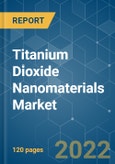The titanium dioxide nanomaterials market is expected to register a CAGR of more than 8% during the forecast period. Some of the prominent trends that the market is Increasing demand from the cosmetics industry and growing demand in the Asia-Pacific region.
Key Highlights
- Increasing restrictions on titanium dioxide nanoparticles regarding safety issues are likely to hinder the market’s growth.
- Increasing applications of titanium dioxide is expected to act as an opportunity for the market.
Key Market Trends
Increasing Demand from the Paints and Coatings Industry
- Titanium dioxide nanomaterials are the most widely used white pigment materials in the paints and coatings industry, owing to their UV absorption and photocatalytic sterilizing properties. They are majorly used in the coatings industry because they efficiently scatters visible light, and thereby, impart whiteness, brightness, and opacity, when incorporated into coatings.
- Titanium dioxide nanomaterial products are sometimes coated with silica and alumina and doped with another metal for specific applications in the coatings industry.
- The global paints and coatings industry is experiencing a boom, with the rapid growth of the end-user industries, like building and construction and automotive.
- Construction activities in all the 19 EUROCONSTRUCT countries increased by 3.2%, owing to the increasing demand in construction in these countries. Furthermore, the market is expected to increase by about 2.3%, and it may stabilize at around 1% in 2020-2022.
- The construction industry in Asia-Pacific is expanding at a very rapid rate primarily in the major economies, such as China, India, and other ASEAN countries. According to the Chinese government, the construction sector of the country is expected to witness a growth by 5.9% and 6.1% during 2019 and 2020, respectively.
- Such factors are expected to increase the demand for titanium dioxide nanomaterials in paints and coatings industry.
United States to Dominate the North America Region
- The United States is the largest and most powerful economy worldwide with the country’s GDP registered a growth by 2.9%.
- The United States is the global leader, in terms of the number of titanium dioxide nanostructures produced. The United States provides 53% of all TiO2 products in the market.
- The demand for cosmetics in the country is also increasing at a rapid pace. The revenue from the cosmetic industry is expected to reach more than USD 17 billion by the year 2020.
- The strong consumer confidence and the rising per capita disposable income are the factors that are boosting the demand for manufacturing cosmetics.
- All such factors are expected to increase the demand for titanium dioxide nanomaterials in the North America region.
Competitive Landscape
The titanium dioxide nanomaterials market is consolidated, with few players holding the major share in the market. Key players in the titanium dioxide nanomaterials market include ACS Material, Altair Nanomaterials, American Elements, Cristal, MkNano, Shanghai Xiaoxiang Chemicals Co., Sigma Aldrich, Tronox, US Research Nanomaterials, and Xuancheng Jinguri New Material, among others.
Additional Benefits:
- The market estimate (ME) sheet in Excel format
- 3 months of analyst support
This product will be delivered within 2 business days.








